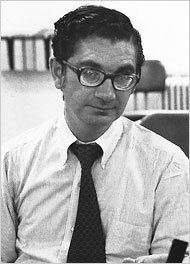Language English Movies The Marcus-Nelson Murders | Role Journalist Name Selwyn Raab | |
 | ||
Occupation Journalist, Writer, Investigative Reporter Genres BiographyHistoryCase studies Subjects Organized CrimeUS State & Local HistoryReference Notable works Justice in the Back Room Mob Lawyer Five Families: The Rise, Decline, and Resurgence of America's Most Powerful Mafia Empires Nominations Edgar Award for Best Fact Crime | ||
City talk selwyn raab author five families the rise america s most powerful mafia empires
Selwyn Raab (born June 26, 1934 in New York City) is an American journalist, author and former investigative reporter for The New York Times. He has written extensively about the American Mafia and criminal justice issues.
Contents
- City talk selwyn raab author five families the rise america s most powerful mafia empires
- Early life and career
- New York World Telegram and Sun 19601966
- NBC News 19661971
- The 51st State WNET 13 19711974
- The New York Times 19742000
- Five Families 2000 present
- Awards and honors
- References
Early life and career
A native New Yorker, Raab grew up on Manhattan's Lower East Side. He attended Seward Park High School and later graduated from the City College of New York where he received a B.A. degree in English Literature in 1956. At City College he was campus correspondent for The Times and an editor of Observation Post, a student newspaper. His first jobs as a reporter were with the Bridgeport Sunday Herald newspaper in Bridgeport, Connecticut and The Star-Ledger newspaper in Newark, New Jersey.
New York World-Telegram and Sun (1960–1966)
From 1960 to 1966, he joined the New York World-Telegram and Sun. He was originally assigned as an education reporter. On the education beat he covered declining reading and mathematics test scores, attempts to unionize teachers and racial integration disputes until he discovered that mob-connected contractors were behind a major scandal concerning improper construction and renovation which endangered the safety of thousands of students in the school system.
Later as investigative reporter at the New York World-Telegram, he was instrumental in finding evidence that exonerated George Whitmore Jr. of false charges for having slain Janice Wylie and Emily Hoffert in the notorious Career Girl murders in 1963. He also uncovered evidence that led to the dismissal of a third murder accusation against Whitmore.
NBC News (1966–1971)
While producer and news editor for WNBC television news, (1966-1971), Raab also wrote a book about the case Justice in the Back Room, published in 1967. The book was nominated for an Edgar Award by the Mystery Writers of America for Best Fact Crime Book in 1968. Universal Studios bought the television rights, transforming Raab into a fictional detective named Theo Kojak, portrayed by Telly Savalas in the series Kojak. The series ran for five years. The series was spun off from the CBS television movie, The Marcus-Nelson Murders, which won 2 Emmy Awards in 1973.
The 51st State – WNET-13 (1971–1974)
In 1971, he became a reporter-producer at the Public Broadcasting television station WNET-13 on the news program The 51st State, where he continued working on the Whitmore case. He proved that Whitmore was elsewhere on the day of the killings and helped clear him. It took seven more years to locate a witness whose testimony exonerated Whitmore in 1973 from an unrelated attempted rape conviction. Whitmore was released from prison after serving nine years for a "wrong man" conviction for attempted rape. Raab received a New York Press Club Award for Outstanding Television Journalism for his work on the case. His work was also nominated for an Emmy Award for Outstanding Achievement in News Feature Reporting Within a Regularly Scheduled News Program for the feature Shooting Gallery aired on December 18, 1973 (WNET). He became Executive Producer of The 51st State until he left for The New York Times in 1974.
The New York Times (1974–2000)
In 1974, Raab became a metropolitan staff reporter for The New York Times where he covered criminal justice and government corruption stories, particularly those that involved the American Mafia. During this period, he exposed perjured testimony and police and prosecutorial misconduct surrounding the triple murder convictions of boxer Rubin "Hurricane" Carter and his co-defendant, John Artis, which led to the ultimate dismissal of all accusations against them. Both men were cleared after serving lengthy prison sentences.
Five Families (2000-present)
Raab left The Times in 2000. His book, The New York Times Bestseller, Five Families: The Rise, Decline, and Resurgence of America's Most Powerful Mafia Empires was published in 2005. He is a consultant on organized crime for TV documentaries, primarily on the History and Biography channels. He was involved as a consultant for the 6-part series "Inside the American Mob", being interviewed with prominent Cosa Nostra members as well as current and former FBI agents, US Attorneys and detectives who were heavily involved with the pursuit of the Mafia and giving first-person accounts of major events involving the mob. He was an adviser on scripts for the 10-part television series, The Making of the Mob: New York based partly on Five Families which premiered on June 15, 2015, on AMC.
